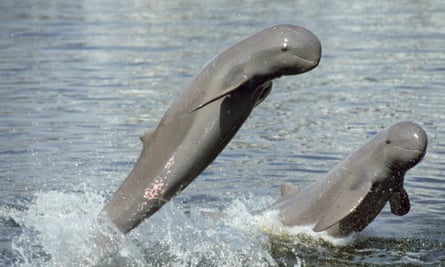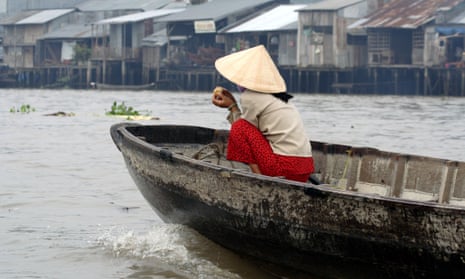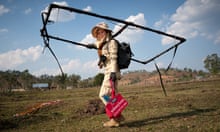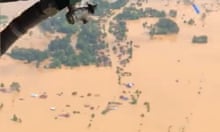In a remote part of northern Laos, history is being made. Construction has begun on the final stage of the $3.5bn Xayaburi dam – the first dam to span the entire mainstem of the lower Mekong River. At the same time, in southern Laos, where the Mekong River’s braided channel flows languidly around thousands of sandy islands, preliminary work has begun on the roads and bridges needed to build the $300m Don Sahong dam.
This historic moment, however, is an ominous sign for the river’s 60 million downstream residents, some of the planet’s most endangered wildlife species and the world’s most productive inland fishery. With a total of 11 dams planned for the lower Mekong River, the future of this mighty waterway is in grave danger.
Harmful hydropower
Thailand has committed to increase its production of renewable energy to 25% of output by 2021 using a variety of sources, including hydropower. The Energy Generating Authority of Thailand (EGAT) will purchase over 90% of the power from Xayaburi dam and may purchase power from Don Sahong as it looks to bolster Thailand’s fast-growing demand for energy and reduce its dependency on fossil fuels.
The Xayaburi dam is being developed by Thailand’s CH. Karnchang while the Don Sahong dam is being built by Malaysia’s Mega First Corporation Berhad. Both dams have met steadfast opposition from broad coalitions of environmental groups and local communities, which say the developments will be disastrous for the millions of people who rely on the river’s rich bounty of fish for their livelihoods and food security. A quarter of all the freshwater fish caught across the globe are pulled out of the Mekong and the river is second only to the Amazon for the number of fish species, with new species being discovered every year.

The growing scientific evidence against the proposed Don Sahong dam is stark. It will block the Hou Sahong channel, the main passage for dry-season fish migrations on the Mekong. This will put the world’s largest inland fishery at risk and threaten the spectacular torrent of water that rushes over Khone Falls, a popular tourist attraction.
What’s more, the dam builders intend to excavate millions of tons of rock using explosives, creating strong sound waves that could kill dolphins located only two miles away in neighbouring Cambodia. There will also be a damaging impact on other rare species, such as Mekong giant catfish and freshwater stingrays.
Taking action
For the Xayaburi dam, the impact could be felt as far away as the Mekong Delta in south-western Vietnam, which feeds half the country’s 90 million people and makes Vietnam the world’s second largest exporter of rice. Sand will be trapped behind the dam, threatening a delta that is already under extreme pressure from climate change, unsustainable sand-mining and existing Mekong dams in China.
Closer to home, Thailand’s Supreme Administrative Court has agreed to hear a lawsuit from a group of villagers in Thailand who will be severely affected by the Xayaburi dam. The lawsuit contends that EGAT’s power purchase agreement (PPA) was unconstitutional due to the lack of environmental and social impact assessments and a failure to adequately consult with them – a key requirement of the Mekong River Agreement signed by the member states of the Mekong River Commission (Cambodia, Thailand, Vietnam and Laos). The PPA is the main guaranty for the lenders, thus its suspension could halt construction.
The Mekong River Commission has so far been unable to provide a platform to reach consensus on these projects. Downstream countries have consistently voiced objections to the dams and called for fully transparent, independent transboundary assessments of both the environmental and social impacts, along with a 10-year moratorium on mainstem dams until studies are completed. These calls have fallen on deaf ears as Laos ramps up construction.
Seeking solutions
A possible alternative to the dam is the Thako Water Diversion Project, which would produce almost as much energy as the Don Sahong dam but with much less damage. The Thako project would not involve a dam or reservoir across any of the channels of the mainstem Mekong River in the Khone Falls.
To date, the Thako project has never been seriously considered and is no longer on the table, but no explanation has been given for this.
What happens to the Mekong River has global implications, whether it is to fish stocks, rice exports, sand supplies or climate regulation. Furthermore, it is essential that the demand for energy and economic development be balanced with the need to keep this iconic, culturally significant and environmentally bounteous river as intact and free-flowing as possible.
Balance is the key word if countries like Thailand are to achieve energy security and protect natural resources and livelihoods. What’s needed is an energy mix that includes increasingly affordable solar power, wind power, geothermal power and sustainable hydropower that leaves the smallest footprint possible.
The water hub is funded by Grundfos. All content is editorially independent except for pieces labelled ‘brought to you by’. Find out more here.
This content is brought to you by Guardian Professional. Become a GSB memberto get more stories like this direct to your inbox.







